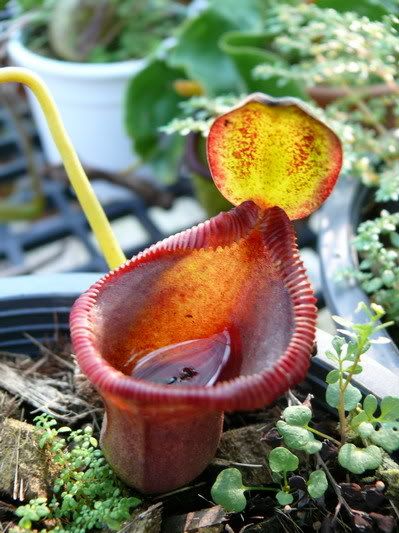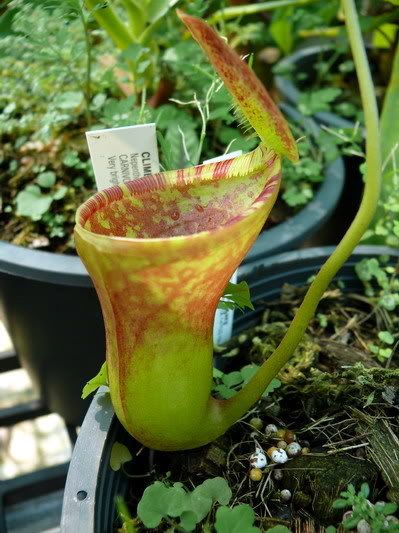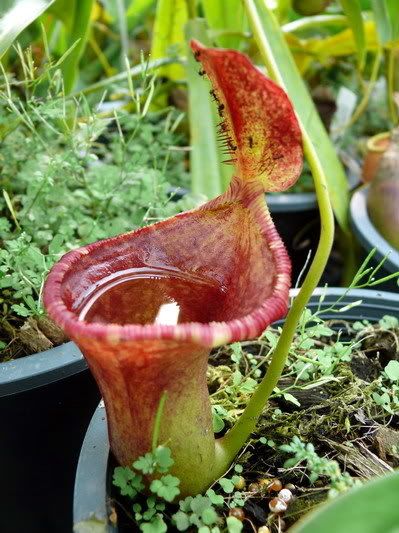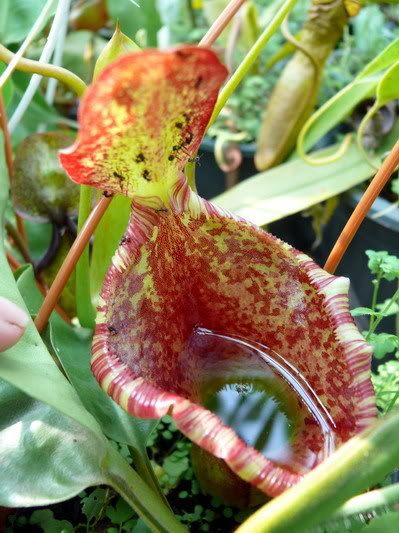|
|
Post by tropicpitchers on Feb 21, 2008 0:00:41 GMT 8
Hi all, 
Here is N.lowii x ventricosa-red, good growing in tropical conditions, the pitcher is much liked N.lowii and have many fangs under the lid, great shape with exellent colors.
Cheers,
Nont        
|
|
|
|
Post by phissionkorps on Feb 21, 2008 5:05:12 GMT 8
Another plant I wish I could get my hands on....
|
|
|
|
Post by artificialive on Feb 21, 2008 18:23:02 GMT 8
Hi,
this is an extremely beautiful hybrid specimen. Does it inherits the ventricosa behavior that it can be grown in the lowlands?
Naj
|
|
|
|
Post by David on Feb 22, 2008 9:05:49 GMT 8
I like the picture with the ants under the lid feasting on the nectar... and feeding the pitcher as well... haa, haa...  |
|
|
|
Post by isaacgoh on Feb 22, 2008 14:03:58 GMT 8
Wow, your Lowii hybrid is really a masterpiece. Too bad BE does not have this hybrid available for sale now, otherwise I would have ordered.
Does your Lowii hybrid grows slowly or faster growth?
Rgds,
Isaac
|
|
|
|
Post by tropicpitchers on Feb 23, 2008 0:01:51 GMT 8
Wow, your Lowii hybrid is really a masterpiece. Too bad BE does not have this hybrid available for sale now, otherwise I would have ordered. Does your Lowii hybrid grows slowly or faster growth? Rgds, Isaac Hi Isaac, This hybrid I have ordered from EP. And it grows faster in my lowland conditions. Cheers, Nont  |
|
|
|
Post by tropicpitchers on Feb 23, 2008 0:08:24 GMT 8
 Hi, this is an extremely beautiful hybrid specimen. Does it inherits the ventricosa behavior that it can be grown in the lowlands? Naj Thanks a lot Naj. Yes, for ventricosa hybrids are exellent growing in my lowlands I will show others ventricosa hybrids later but for pure ventricosa is hard to grown in my lowlands. My lowlands degree are Day : 28 - 35C Night : 22 - 29C Cheers, Nont
|
|
|
|
Post by rainforestguy on Feb 23, 2008 1:30:09 GMT 8
May I suggest growing ventricosa from seed originals. I have struggled as well with growing tc clones of ventricosa, but seedlings (the kind EP crosses) have grown very well for me. I have huge vines disappearing into shrubbery all lined with many many green-yellowish uppers all along a hedge and wall. I have also grown them well in hanging baskets but they too become long vines tangling among my many hybrid plants.
growing them in a media which is well draining, yet able to hold moisture is a must. A peat-bark or peat-perlite mixture works very well. Good air circulation, indirect light and or filtered light all are ingredients to a successful culture.
M
|
|
|
|
Post by agustinfranco on Feb 25, 2008 13:02:14 GMT 8
Hi Michael:
the thing with ventricosa is that we all tend to consider this species as a single clone, regardless whether this plant is red, cream coloured, or big mouthed. I think there are variants of ventricosa which likes hotter weather than the others.
Some people believe all ventricosas are the same, but they are not, and this has nothing to do whether they come from TC or not, as many australian growers, struggle with ventricosa variants introduced from presumptively wild collected plants in the early 80's. Some are easy to grow, but others aren't easy at all.
Gus
|
|
|
|
Post by rainforestguy on Feb 28, 2008 5:09:02 GMT 8
My current collection houses about fifty N. ventricosa variants (all from seed). Each plant is a good grower producing prolific pitchers of good size and color. My original tc cloned versions of ventricosa have all died out and or become spindly and makes small pitchers. I suppose if I lived in a cooler area, these might be grand plants (not!).
The hybrid of N. lowii is highland, and ventricosa also highland, yet their offspring is easily grown and kept in warmer conditions. This trend doesn't always have to denote a hybrid, as two forms of the same highland species crossed together will produce progeny that has the same benefits of growing in a wider temperature range as how people perceive how a hybrid of two different species would behave.
This we have seen in N. maxima, N. truncata highland, N. boschiana, N. veitchii, N. sibuyanensis, etc. all from seeds. And yes, there is a difference between seed and tc plants to adapt to various growing conditions.
M
|
|
|
|
Post by nepaholic on Feb 28, 2008 13:20:16 GMT 8
What a nice plant. To bad that this plant is so rar and not aviable.
|
|
|
|
Post by agustinfranco on Feb 29, 2008 7:53:47 GMT 8
My argument on the clonal diversity of ventricosa is based on this: www.exoticaplants.com.au/welcome.aspx?page=72&mid=2&cat1id=1&cat1name=Nepenthes+Species&keysearch=&catpage=16If you see clearly, Mr. Mansell offers different clones of ventricosa, yet some are classified as intermediates others as highlands. I wonder why?  People have the misconception that ventricosas are the easiest plants to grow, but yet, i have heard people trying to grow them in colder areas without success. I believe they like more warmth than many of us were led to believe based on empirical experience as their phillippino heritage prevails. Now that there are X Ventratas sold as ventricosas worldwide does not help us understand the growth requirements for this species either. Gus |
|
|
|
Post by rainforestguy on Feb 29, 2008 9:35:04 GMT 8
The example you cite is my example as well. The many seedling variations exist to where each seedling has adapted to a particular range, yet they all originate from more or less the same gene pool. The "clone" listed are cuttings from seed originals from crossing various F1, and F2 clones together.
Imagine if we had an opportunity to do this with N. hamata, lowii, etc.
M
|
|
|
|
Post by phissionkorps on Feb 29, 2008 9:36:59 GMT 8
Off topicish, but ventricosa (d) and ventricosa K #2 are amazing.
|
|